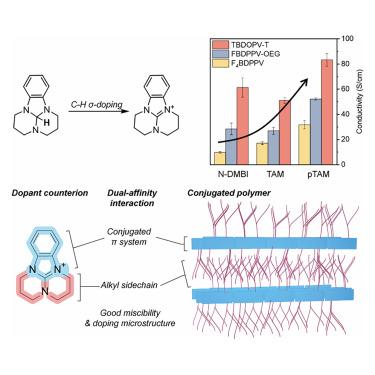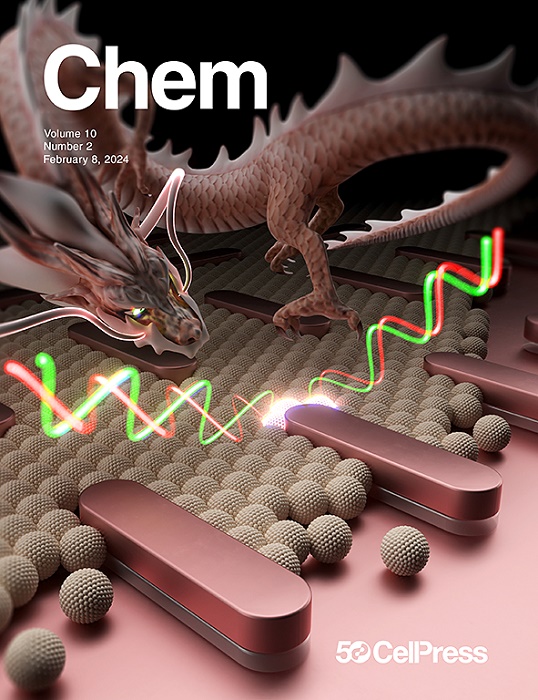Achieving well-ordered microstructure and enhanced conductivities in n-doped conjugated polymers via dual-affinity dopant
IF 19.6
1区 化学
Q1 CHEMISTRY, MULTIDISCIPLINARY
引用次数: 0
Abstract
Doping is a key approach to adjusting the electrical conductivities of polymer devices. However, the disruption to the microstructure of conjugated polymers from counterions of the dopant is the crucial factor limiting performance improvement. Herein, we propose a dual-affinity strategy for dopant design and present a novel n-type dopant, pTAM, with a 2-aminobenzimidazole triaminomethane structure. This pTAM dopant can significantly improve the electrical conductivity of several classic conjugated polymers with a 40%–240% increase in electrical conductivities compared with polymers doped by the widely used dopant 1,3-dimethyl-2-phenylbenzimidazoline (N-DMBI), reaching 83.3 ± 5.1 S cm−1. The enhanced performance is attributed to the matched interaction between pTAM cation and doped conjugated polymer, maintaining a well-ordered microstructure. Our work emphasizes the importance of the dopant-polymer microstructure relationship to the electrical performance, providing a corresponding effective strategy of dopant design for organic electronics and modern semiconductors.

通过双亲和掺杂剂实现n掺杂共轭聚合物的有序微观结构和增强电导率
掺杂是调节聚合物器件电导率的关键方法。然而,掺杂剂的反离子对共轭聚合物微观结构的破坏是限制性能提高的关键因素。在此,我们提出了一种双亲和策略来设计掺杂剂,并提出了一种新型的n型掺杂剂,pTAM,具有2-氨基苯并咪唑三胺甲烷结构。与广泛使用的掺杂剂1,3-二甲基-2-苯基苯并咪唑啉(N-DMBI)相比,该pTAM掺杂剂可以显著提高几种经典共轭聚合物的电导率,电导率提高40%-240%,达到83.3±5.1 S cm−1。这种增强的性能是由于pTAM阳离子与掺杂的共轭聚合物之间的匹配相互作用,保持了良好的微观结构。我们的工作强调了掺杂-聚合物微观结构关系对电性能的重要性,为有机电子和现代半导体的掺杂设计提供了相应的有效策略。
本文章由计算机程序翻译,如有差异,请以英文原文为准。
求助全文
约1分钟内获得全文
求助全文
来源期刊

Chem
Environmental Science-Environmental Chemistry
CiteScore
32.40
自引率
1.30%
发文量
281
期刊介绍:
Chem, affiliated with Cell as its sister journal, serves as a platform for groundbreaking research and illustrates how fundamental inquiries in chemistry and its related fields can contribute to addressing future global challenges. It was established in 2016, and is currently edited by Robert Eagling.
 求助内容:
求助内容: 应助结果提醒方式:
应助结果提醒方式:


